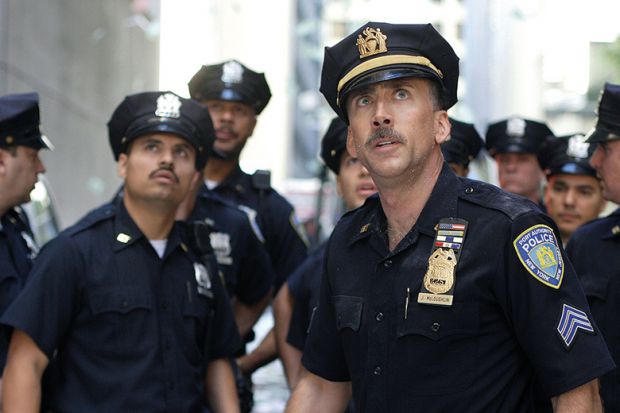“Birmingham is seen as a centre of jihadism and fundamentalism,” said Jonathan Harris, head of the School of Art at Birmingham City University. “We are right in the middle of the city and so have a responsibility to put on this kind of event…There is not much serious academic debate about the history of terrorism and its relation to art, partly because of the Prevent agenda and arguments about free speech on campus. We were trying to put the current discussion in a historical context.”
Professor Harris was talking about a conference, held in the city on 7 June, on “terrorism and cultural freedom” that brought together researchers from the University of Barcelona, the University of Chicago and Columbia University in New York as well as BCU.
One contributor went all the way back to “Shakespeare and terrorism”.
Artistic responses to 9/11 such as Oliver Stone’s 2006 film World Trade Center (pictured), argued David Roberts, professor of English at BCU, took the form of “assertions of nationhood designed to unify generations, races and classes in a single narrative of values and character, often coalescing in the shape of the white, male, blue-collar hero”.
But in contrast, in the aftermath of the Gunpowder Plot of 1605, “when troops were mustering in Warwickshire and plotters being flushed out of hiding”, Shakespeare decided to “respond to the news sensation in a way few others before or since have dared…[In writing Macbeth] he [drew] us into understanding, sympathising and even identifying with the mind of the terrorist.”
Other historical papers explored the contested legacy of the Franco regime in Spain and the era of “skyjacking” in the 1960s and early 1970s. One artistic response to the latter saw performance artist Chris Burden “hijack” a television show by holding a knife to his friend and interviewer Phyllis Lutjeans and insisting that the “event” should be broadcast live.
Jonathan Day, reader in transmedia arts at BCU, reflected on the possible role of “art school activism” and drew on his “own experience of non-violent creative opposition to a regime” when, during a short-lived political “thaw” in Belorussia in 1993, his band toured the country and “played alongside Ulis – a Belorussian rock band of state-funded sculptors – in an unfinished theatre liberated from the government by artist activists”.
Other speakers brought the story up to date by looking at drone warfare, inflammatory political cartoons and “the archiving of political conflict in the Middle East”.
Dima Saber and Nick Webber, senior lecturers at BCU, considered how Hezbollah and Islamic State have both modified existing video games and created their own in order to challenge the picture of civilised American “heroes” and violent archaic Arabs presented – for example, in the Call of Duty franchise.
But in exploring such topics and imagery, did Professor Harris feel that they were venturing on to contentious and even dangerous territory that other universities might shy away from?
“It was a straightforward academic event,” he replied. “We mostly showed still footage from the Islamic State video games, which are very crude and badly produced. In context, none of this material could possibly be seen as of any use in recruiting.”
POSTSCRIPT:
Print headline: Terrorism’s links to art considered by academics
Register to continue
Why register?
- Registration is free and only takes a moment
- Once registered, you can read 3 articles a month
- Sign up for our newsletter
Subscribe
Or subscribe for unlimited access to:
- Unlimited access to news, views, insights & reviews
- Digital editions
- Digital access to THE’s university and college rankings analysis
Already registered or a current subscriber?




